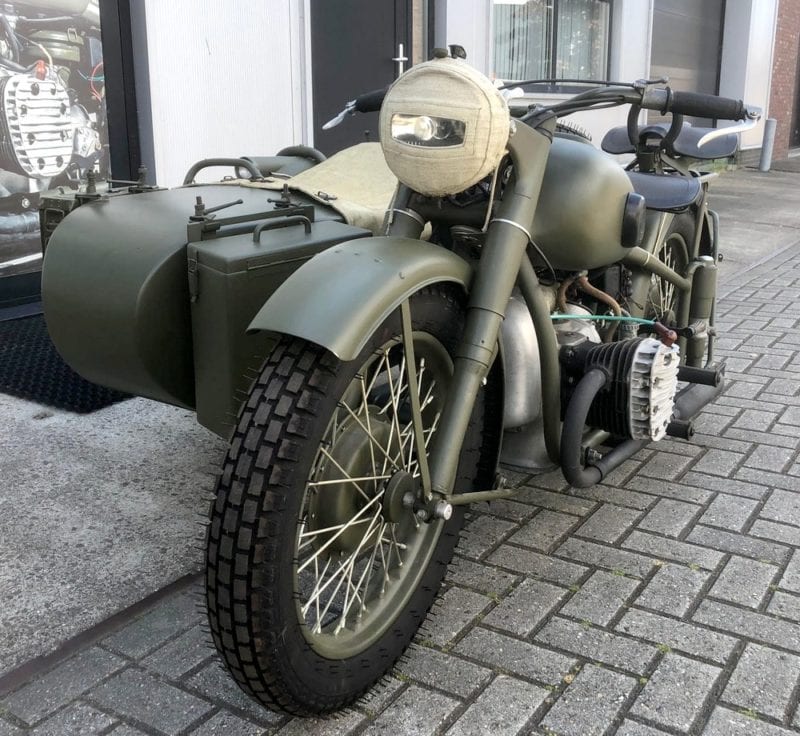Seventy-five years after the liberation, the WLA and C models from Harley-Davidson, the BMW R75 and thick Zündapp boxers have actually become unaffordable. Other European ex-army motorcycles from WWII are still reasonably to affordable. Think of the British and the now recognized classic Russian M72 models (which are clones of the BMW R71). For a correct copy of it, you can now easily tap off 5 grand. But that is less than a quarter of the value of an authentic ex-army motorcycle Harley-Davidson from before 1945.
Values from before and after WWII
The end of WWII has drawn a thick line in the entire military transport scene: Until 1945 = DURATION. For motorcycles (and other vehicles) of that time, when serious wars and similar inconveniences were fought, the prices are much lower. Despite the fact that the majority of these machines are now recognized 'classic' due to their long service life. And that the days of the really tough guys after WWII were over? That's because the Jeeps could do everything better.
For small local transport we have, for example, a former German conscript: A Hercules BW 125. BW stands for Bundesweht. 125 Represents the unimpressive but extremely practical displacement.
Inexpensive and deployable
Hercules, that was a lot. In the XNUMXs, for example. When most motorcyclists still drove a motorcycle because they had no money for a car. The Super Ouwe Nato Joekels remember this from the time when Berlin was divided in two by a huge fence.
The hit for the army motorcycle came when the Bundes Wehr decided that the Hercules BW 125 had to become the new motor ordinance (Kradmelder) bicycle. The successor to the Maico BW 250. And Klacks - read: Ernst Leverkus, the man who was to motorcycling in the XNUMXs and XNUMXs what Rihanna is to pop music today - didn't like it.
According to him, Hercules' army motorcycle was too heavy in weight, too light in cubic capacity, too high revs and structurally wrong because it was a two-stroke. Klacks' opinion was so important at the time that the newspapers stated that He didn't like the Hercules. That the Ministry of Defense went wide to explain the matter clearly… The Hercules Typ (pronounced elongated as 'tuuup') 1 and Typ 2 (from 1977) differed in details. Most eye-catching was the swing arm front fork on the T1 models. Also, early T1s had a purely symbolic air filter, a normal contact ignition and so on. The T2 models clearly looked cooler. More like enduro bikes. Ample thought had been given to luggage options and limiting damage after falling. The 123 cc Sachs engine was one of the GS series. So an enduro / off-road block. A low one and two, then a big step to three, four and five. With a little courage, policy and loyalty, it went all in any case 80+. The first engines were delivered in the early 1s. Part of it remained in mob (ilization) supplies. And where possible, parts were enthusiastically changed. So a T2 with a large TXNUMX air filter is fine!
Just enjoying
Driving on about 125 you do by looking through the bend. The unsightly two-wheeler feels like something that is a natural extension of your back. Such a singing two-stroke of only 123 cc just makes you very light-hearted. You will drive in a very Italian way. No idea what is or is not allowed. But look what is possible! Fortunately you are invulnerable on and Hercules K 125 BW. Just too small to be hit.
Also read:
- More in our section classic engines
- Army vehicles and WWII
- Army motorcycles. 75 years after WWII
- Army vehicles and motorcycles from 1940-1945
- Matchless for the army: NOT!










Hello Sir,
What is the value of the bike in this condition (as the one on the trialer)? Knowing that all the parts (such as the leather light caps) as in the picture above are included.
Our thing, he does not turn (piston is stuck in the cylinder).
Hank for the info.
Was für ein schlecht detective Article ...
'Molotov' Fährst du russisch Know Sie Richard Busweiler? http://www.uraldnepr.nl/
Hätte ein schöner Notice sein können wen er nicht so Caves schlecht űbersetzt wäre. Űberprűft das nobody ??
Übersetzungen sind leader von Maschinen be mandacht (Google neural translation), daher nicht perfect, aber besser as nichts.
Aber wir bleiben positiv: Know Sie Gekra Motors in Dieren (bei Arnhem) https://www.gekra-motors.nl/webshop/ and Potomac Classics in Terborg? https://www.potomacclassics.nl/?